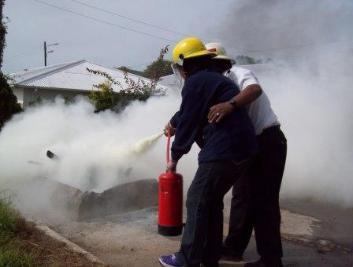Fire Extinguishers
Managers or heads of department (or their designees) are responsible for ensuring that their department/division/section has fire fighting equipment and that all occupants are familiar with these. Please do NOT use the equipment in your buidling for demonstrations.
It is a punishable offence if any person tampers with or misuses any safety equipment (Occupational Health & Safety Act, Section 38).
Fire extinguishers for demonstration purposes: contact Campus Protection or Engineering
Fire extinguishers from RU Engineering
RU Engineering section RU ext 8238 / 8236 / 7451; or speed dial 5231 / 5031 - is responsible for supplying and maintaining RU's fire fighting equipment - approximately 450 fire hose reels and 1500 handheld fire extinguishers.
-
Annual servicing: Engineering contracts a service provider to inspect and service all fire fighting equipment on campus. If there are any oversights or concerns, contact Engineering on RU ext 8238 / 8236 / 7451; or speed dial 5231 / 5031.
-
Fire hose reels: Only use to fight class A fires (water has a cooling effect, but can conduct electricity). Common on campus. Rely on a functioning municipal water supply.
-
Hand held extinguishers:
-
Dry powder/DCP: Use to fight class A, B, C & D fires. Common on campus. Multi-purpose dry chemical extinguisher, filled with a yellow powder, mono ammonium phosphate, which smothers the fire and absorbs some of the heat. Non-conductive but mildly corrosive if moisture is present, so proper clean-up is essential.
-
Carbon dioxide: Use to fight class B and class C fires. Mostly in kitchens, computer rooms, laboratories. CO2 displaces O2 (oxygen) and smothers the fire. It has limited cooling power, and not very effective on class A fires as O2 is only temporarily displaced. Environmentally friendly. Leaves no residue, so clean-up is not needed.
-
Fire blanket: Use to fight class B fires. Mostly in kitchens and laboratories. Made of fire-retardant material such as fibreglass or wool. Place blanket over the fire to cut off supply of oxygen.
-
-
RU Fire Marshals should check fire extinguishers from time to time, and inform their Health & Safety Rep of findings. Issues to consider include:
-
Check that it is properly mounted on the wall;
-
Check there are no obstructions - if any, should be moved as soon as possible;
-
Check the label to see when it was last inspected - if more than a year ago, contact Engineering;
-
Check the plastic seal - if broken, contact Engineering;
-
Check the gauge (handheld extinguisher) - if position has moved out of green - into red - area, contact Engineering
-
Classes of fire
-
A - solid organics: Fires involving ordinary solid flammable materials such as wood, paper, coal, plastic and fabrics.
-
B - liquid/gas: Fires involving flammable liquids and gases such as petrol, paraffin, alcohol, benzene and oils.
-
C - electrical: Fires involving contact with live electrical installations such as short-circuiting machinery and overloaded electrical cables.
-
D - combustible metal: Fires involving combustible metals such as aluminium (in some pots and pans, etc), magnesium & titanium (used in lightweight equipment). Most metal fires happen in the presence of sawdust, machine shavings and other metal shavings.

Fighting fire with dry powder/DCP hand-held extinguisher.
More info:
RU Safety, Health & Environmental Officer: 046-603.7205 or safety(at)ru.ac.za
Questions and answers: visit the Labour Guide Forum
An extract from the Occupational Health and Safety Act (1993), Environmental Regulations for Workplaces (1987) - retrieved February 11, 2009 :
Section 9. Fire precautions and means of egress
1. In order to expedite the evacuation of a workplace in case of fire, every employer shall ensure that -
a. any emergency escape door from any room or passage or at a staircase shall, as far as is practicable, be hung so as to open outwards;
b. every door of a room in which persons may be present, and every door of a passage or at a staircase serving as a means of exit from such room, shall be kept clear and capable of being easily and rapidly opened from inside so as to ensure quick and easy evacuation;
c. the provisions of paragraphs (a) and (b) shall also be complied with in respect of the outer escape exit from the workplace;
d. staircases and steps leading from one floor to another or to the ground shall be provided with substantial hand-rails;
e. staircases intended to be used as fire escapes shall -
i. be constructed of non-combustible material;
ii. be kept clear of any material or other obstruction; and
iii. not terminate in an enclosed area;
f. staircases, passages and exits intended for escape purposes shall be of a width and of a gradient which will facilitate the quick and safe egress of the number of persons intended to make use of them; and
g. having regard to the size, construction and location of a workplace, the number of persons, and the activity therein, such workplace is provided with at least two means of egress situated as far apart as is practicable.
2. Having regard to the size, construction and location of the workplace, and the amount and type of flammable articles uses, handled or stored on the premises, an employer shall provide on the premises an adequate supply of suitable fire-fighting equipment at strategic locations or as may be recommended by the fire chief of the local authority concerned, and such equipment shall be maintained in good working order.
Return to Rhodes University's Safety front page. Questions/Suggestions? Contact safety(at)ru.ac.za
Last Modified: Mon, 21 May 2018 14:28:17 SAST

